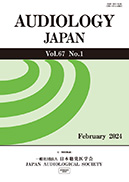
- |<
- <
- 1
- >
- >|
-
Shin-ichi UsamiArticle type: review-article
2024Volume 67Issue 1 Pages 43-53
Published: February 28, 2024
Released on J-STAGE: March 14, 2024
JOURNAL FREE ACCESSAdvances in genetic analysis technologies have made it possible to classify hearing loss, which previously had unknown causes, that was previously often classified as idiopathic into subtypes based on the causative gene. The development of cochlear implantation has also enabled otologists to offer new treatment options for hearing-impaired patients. The authors have made attempts to realize personalized medical treatment for hearing loss based on scientific evidence obtained through genetic analyses for hearing loss. This review will introduce how the results of basic research have been fed back to translated into clinical practice and implemented in society.
View full abstractDownload PDF (2228K)
-
Sumito Jitsukawa, Kaede Sato, Ayami Kimura, Aya Kaizaki, Etsuko Saikaw ...Article type: Original article
2024Volume 67Issue 1 Pages 54-60
Published: February 28, 2024
Released on J-STAGE: March 14, 2024
JOURNAL FREE ACCESSHokkaido, where our hospital is located, is a vast area occupying about one-fourth the total area of Japan, and access to specialized medical institutions is a constant problem. We examined the regional differences, in Hokkaido, in the age of the patients at the time of the first visit to our hospital, age at the time of cochlear implant surgery, and time from first visit to cochlear implant surgery in children with congenital hearing loss in Hokkaido. The subjects were 52 patients who underwent cochlear implant surgery between April 1, 2014, and December 31, 2021, at the Department of Otolaryngology, Head and Neck Surgery, Sapporo Medical University. For patients from the remote areas, the first visit was significantly delayed, resulting in a shorter preparation period for the surgery. In addition, a questionnaire survey of the patients suggested a higher physical and mental burden on the patients.
We are attempting to raise the awareness of the population about the need for early diagnosis and treatment intervention for hearing loss, and strengthening remote consultations and medical support for distant areas, and the situation is gradually improving. Further efforts are needed to reduce the anxiety and burden of the patients and their families.
View full abstractDownload PDF (760K) -
Kiyoko Sato, Tomoko Sugiuchi, Rika MiyoujinArticle type: Original article
2024Volume 67Issue 1 Pages 61-69
Published: February 28, 2024
Released on J-STAGE: March 14, 2024
JOURNAL FREE ACCESSIn this study, we provided oral communication instruction to two children with hearing impairment who had associated with high-tone sensorineural hearing loss. Herein, we describe the method of this instruction in detail and the results brought about by the instruction.
For the experimental method, we conducted semi-structured interviews to determine the subjects' perspectives before and after the instruction.
The results revealed that prior to receiving the instruction, the subjects did not have confidence in communication and did not know how to deal with their disability. However, after receiving the instruction, they began to incorporate communication skills such as [listening] and [confirming] into their conversations. In addition, it became possible for them to communicate by exchanging words with the other party, and they perceived a sense of fulfillment.
The subjects were able to recognize their own disability through receiving the instruction for oral communication. Furthermore, the results suggested that this guidance enabled them to use communication skills effectively and to adjust the environment to compensate for hearing difficulties.
View full abstractDownload PDF (697K) -
Masahiro Takahashi, Satoshi Iwasaki, Sakiko Furutate, Shin-ichiro Oka, ...Article type: Original article
2024Volume 67Issue 1 Pages 70-76
Published: February 28, 2024
Released on J-STAGE: March 14, 2024
JOURNAL FREE ACCESSWe conducted a comparative study, comparing subjective evaluations in two cases of bilateral congenital aural atresia treated with a combination of an active middle ear device and bone conduction implant. Questionnaire evaluations were performed using the Hearing Implant Sound Quality Index (HISQUI19) and the Judgements of Sound Quality (JSQ) test, while audiometric evaluations involved a monosyllabic speech discrimination test in noise and a directional hearing test. Both cases showed good questionnaire evaluation results, with no significant differences observed between the use of the active middle ear implant and the bone conduction implant. Furthermore, audiometric evaluations in both cases, when both ears were equipped, demonstrated improvements in the results of speech discrimination in noise and sound localization tests, suggesting that bilateral hearing benefits can be achieved with different devices. Audiometric evaluation showed that Case 2 had a better sound localization ability when using the active middle ear implant, but long-term observations are necessary.
View full abstractDownload PDF (541K)
- |<
- <
- 1
- >
- >|